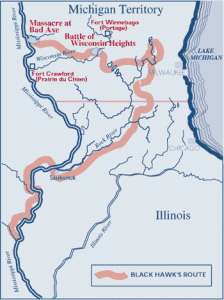
On July 21, 1832 the Battle of Wisconsin Heights was fought between the United States Militia and the Sauk Indians. This conflict was the turning point in the short lived Black Hawk War. This conflict began when the Sauk natives lost their land in a treaty and naturally some members, including Black Hawk, felt that this treaty unfair. Black Hawk then gathered a group of followers and made the journey back to their tribal lands. Once they returned and settled the land they claimed was theirs, the US government sent out a militia squad to force them out of the land claimed by the white settlers. The US militia got word that Black Hawk had struck out against other targets but eventually was making a retreat with the rest of his tribe. The squad of US militia lead by General Henry Atkinson chased him through northern Illinois and into southern Wisconsin.
US Militia’s Long Road to Conflict
Having chased the natives through two states and across hundreds of miles of terrain, while at the same time running low on rations, discontent began to grow with the ranks of Atkinson’s men. Atkinson, knowing he needed more rations, dispatched three brigades to Fort Winnebago (about 60 miles north, near present day Portage, WI) to secure 12 days rations for the rest of the men and immediately return. These brigades, led by Colonel Henry Dodge, General Milton K. Alexander, and Brigadier General James D. Henry, took two days to arrive at Fort Winnebago. Once they arrived, orders were delivered and then the men were told to wait a day while the rations were being put together. In the meantime, it must be mentioned that Fort Winnebago was not a particularly defensible fort. It did not have any artillery and also was not well-fortified. This lead to a tense night while the troops slept outside the fort in their tents. At some point in the night, many of the horses got spooked by something and began to stampede. The sound was described by Lieutenant James J. Justice. “A noise equal to thunder” [1, 1323]. When “two thousand horses [come] at full speed toward an encampment in the dead hour of night” [4, 85], it is a dangerous situation. People can be trampled, equipment can be destroyed and the horses can be trampled themselves. Fortunately for the brigade, nobody was killed but many weapons and other possessions were either lost or destroyed along with the loss of horses. Some of them ran away never to be found, some got hurt and were unfit for battle or travel, and many ran off but were found the next day by the soldiers. This turn of events caused the brigade to delay their departure by two days due to the sheer amount of confusion and injured horses. The final delay before leaving Fort Winnebago was when some of the forces under the control of Colonel Dodge mutinied. The Colonel quickly and firmly had them arrested and sent them away. This act actually brought many of them to their senses and they returned to duty.
As the US forces left Fort Winnebago, they numbered about 750 soldiers. They began to march east towards the Rock River (near present day Hustisford, WI). Here the militia learned from some friendly natives that Black Hawk’s band had moved out north. After traveling slightly north again, it was discovered that they missed Black Hawk again and that he was to the west. The next day, the Americans moved out and quickly picked up on Black Hawk’s trail. As they were following it, they came across a small group of native spies. The small band of two was captured as they admitted they were spies for Black Hawk. As the militia carried on, they began to see more evidence that the enemy was not far ahead. It was possible to see where the natives had dug in the ground and scavenged for food. The militia also saw some personal possessions that were cast aside so that the natives could move faster. Finally, on Saturday July 21, 1832, as the militia was moving through what is present Madison, WI, they began to see and kill a few natives that were on the side of the trail. Some of these natives were physically unable to go any further and just collapsed. Some of them lost loved ones and refused to go on without them. Around twelve natives were killed while only one white man in the militia was wounded. At the same time, the militia were receiving word from scout parties ahead and knew that the natives were not more than a mile and a half ahead of them.

The Americans were fast approaching on the heels of the natives. The goal was to catch up to the natives before they could reach the Wisconsin River just outside present day Sauk City, WI. The militia was pushing so hard that James J. Justice reported, “men who had broke down their horses kept the march on foot while those that were mounted went on in a full trot” [1, 1324]. As the militia began to approach the river, they began to see small bands of natives feigning stands. This caused the Americans to form up every time that they saw this because of not knowing when the ‘feign’ would turn into an all-out attack. According to John Allen Wakefield, the natives did this to “keep us back until they could gain some strong position to fight from” [4, 110-111]. Finally, as the sun began to begin to go down, the Americans received word that the natives were massing for a final stand.
The Battle of Wisconsin Heights
In response to the natives massing, the militia began to assemble and take their places on the battlefield. At about six in the evening on July 21, 1832, the natives came out from their hiding spots and attacked the white militia. The initial attack lasted for only a short time before the natives retreated. After a brief respite, the natives came back and in more numbers. This time with somewhere between 500-600 warriors and they began to take a more aggressive strategy of trying to flank the militia, but “they were headed again by the brave Colonel Jones and his regiment who were on our left, where he met them in the most fearless manner, and opened heavy fire upon them” [4, 111]. This back and forth exchanging fire went on until near dark, and Colonel Dodge decided to “charge upon them at the point of bayonet” [4, 112]. This charge lead to the turning point of the battle. As the militia pushed forward and closed in, the natives thought that they were going to be cut off from the women and children down by the Wisconsin River. This caused the natives to quickly retreat which made the bayonet charge extremely effective.
As the natives retreated, the sun had almost totally gone down but yet the militia still pushed on. The natives began to retreat through the swamp on the river edge with the Americans in pursuit. At this point, the white men began to think that following the natives in the dark into a forest would not be a smart move, especially considering the weather conditions. It had rained all day and walking through the tall grass of the swamp had gotten most of the soldiers’ equipment wet and the weapons would be unable to fire without new gunpowder. Thus, the militia retreated back up the bank of the river near where the battle was fought to regroup and wait until the morning to follow the natives again. According to Henry, “between thirty and forty [dead natives] have been found and others are continually being discovered by our scouts” [4, 860](Justice 860). While this may not seem like a considerable number, it was quite a few compared to the militia’s death toll of one.
Aftermath
After making camp for the night, the United States Militia headed out to meet the enemy once again at first light. During the night, many of the Americans were awakened by a loud voice yelling over their camp in a strange language. According to Charles Bracken, “he spoke a great deal, but his language was not understood” [3, 222]. Unfortunately, the militia’s interpreter had left the brigade immediately following the battle but according to some soldiers who could understand bits and pieces of the language claimed that they, “understood enough to know that he did not want to fight” [2, 294]. But when the militia arrived at the natives’ camp, “it was found that the enemy had all crossed the river during the night, men, women, and children, and had dispersed” [3, 222]. While the militia wanted to follow the natives, there was no way to safely do so without rafts or canoes. While it does seem that the natives got away to safety, it was only temporary. On August 1-2, white settlers caught up to Black Hawk’s party and killed most of the natives as they attempted to cross the Mississippi River. This ‘battle’ is often called the Bad Axe Massacre because of how one sided it was. To quickly compare how lopsided the two sides were: the US military had a large steam boat and the natives had birch bark canoes.
Overall, the Battle of Wisconsin Heights is well known as being the battle that opened up Wisconsin for future settlers to expand into. Looking at the broad picture, it was fairly easy to see that the militia was going to be able to defeat the native. They were better armed, have more supplies, and experienced leadership that knew how to handle the natives. Colonel Dodge had a particularly good reputation as a military leader and also as an Indian fighter. The natives on the other hand had just traveled many miles and were weary travelers. They also had little to no supplies in the end and became desperate. On the return trip many of them were sick and addition to caring for these sick, Black Hawk was also leading the women, children, and elderly. These all would have slowed him down a considerable amount.
Primary Sources
1) Justice, James. Journal – The Black Hawk War 1831-1832. Vol. 2. Springfield: Illinois State Historical Library, 1975.
2) Kett, H.F. The History of Jo Daviess County, Illinois, Containing a History of the County, Its Cities, Towns, Etc., a Biographical Directory of Its Citizens, War Record of Its Volunteers in the Late Rebellion … History of the Northwest, History of Illinois … Con. Chicago: H.F. Kett, 1878.
3) Smith, William Rudolph. The History of Wisconsin: In Three Parts, Historical, Documentary, and Descriptive : Compiled by Direction of the Legislature of the State. Vol. 3. Madison, Wis.: B. Brown, 1854.
4) Wakefield, John Allen. History of the War between the United States and the Sac and Fox Nations of Indians. Jacksonville: Calvin Goudy, 1834.
Secondary Sources
5) Wisconsin Historical Society. “The Battle of Wisconsin Heights, 1832,” 2015. http://www.wisconsinhistory.org/Content.aspx?dsNav=N:4294963828-4294963805&dsRecordDetails=R:CS345
6) Sauk County Historical Society. “The Black Hawk War,” 2015. http://www.saukcountyhistory.org/blackhawkwardisplay.html
7) Titus, W.A. and L.P.K. (1920). “Historic Spots in Wisconsin” Wisconsin Magazine of History 4.1: 55-60 http://www.jstor.org/stable/4630279?Search=yes&resultItemClick=true&searchText=battle&searchText=wisconsin&searchText=heights&searchUri=%2Faction%2FdoBasicSearch%3FQuery%3Dbattle%2Bwisconsin%2Bheights%26amp%3Bacc%3Don%26amp%3Bwc%3Don%26amp%3Bfc%3Doff%26amp%3Bgroup%3Dnone&seq=6#page_scan_tab_contents
8) Frank, Andrew K. (2007). “The Black Hawk War of 1832,” 2015. http://muse.jhu.edu/journals/journal_of_the_early_republic/v032/32.3.frank.html
9) Thayer, Crawford Beecher. The Battle of Wisconsin Heights: An Eye-witness Account of the Black Hawk War of 1832. 1st ed. Fort Atkinson: Thayer, 1983.
Additional Reading
1) “Battle of Wisconsin Heights.” Wikipedia. Wikimedia Foundation. Web. 12 Dec. 2015. https://en.wikipedia.org/wiki/Battle_of_Wisconsin_Heights
2) “Battle of Bad Axe.” Wikipedia. Wikimedia Foundation. Web. 12 Dec. 2015. https://en.wikipedia.org/wiki/Battle_of_Bad_Axe
3) “Battle of Wisconsin Heights: Indian Focus.” Military History of the Upper Great Lakes. Web. 12 Dec. 2015. http://ss.sites.mtu.edu/mhugl/2015/10/12/battle-of-wisconsin-heights-indian-focus/
